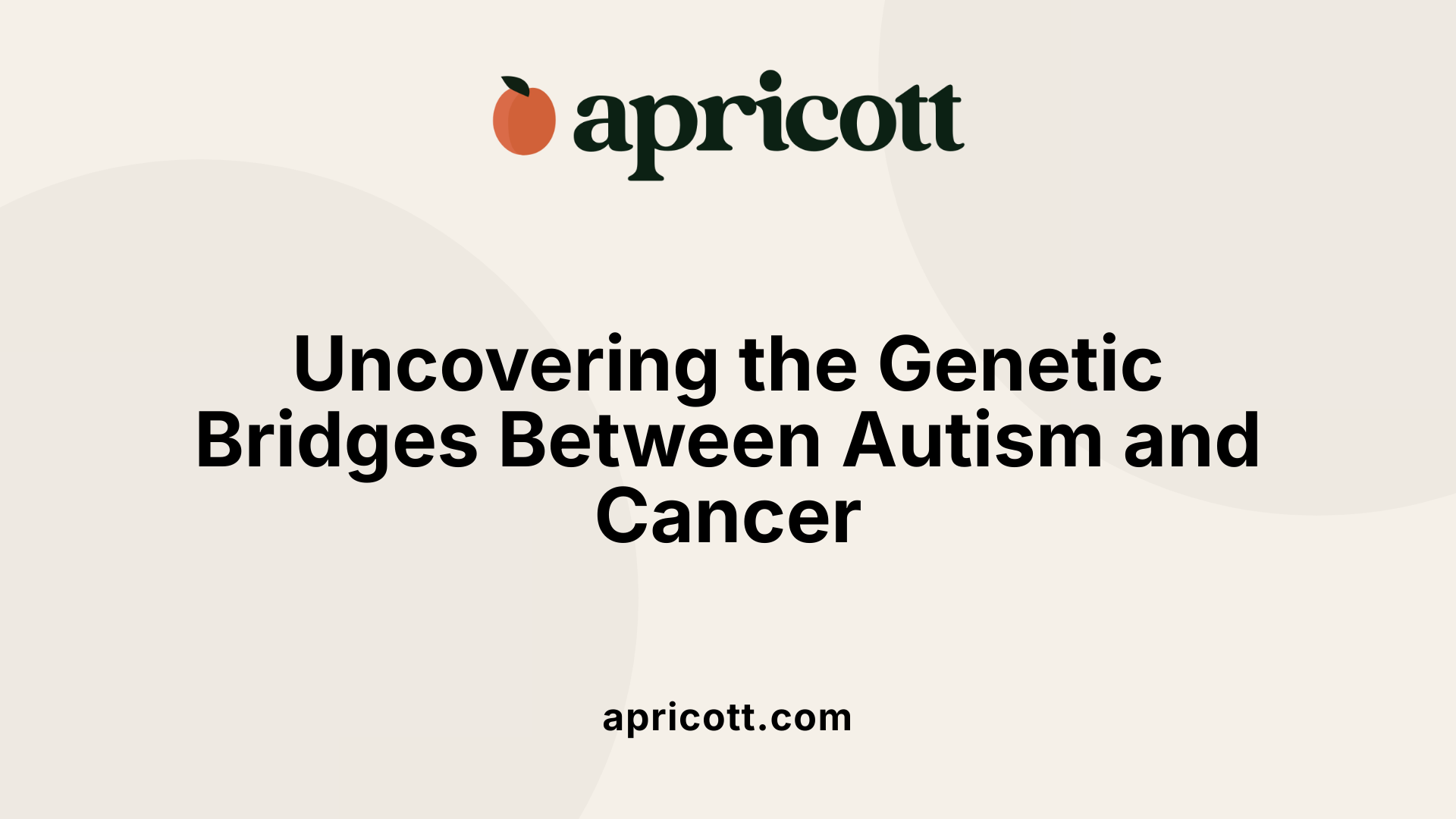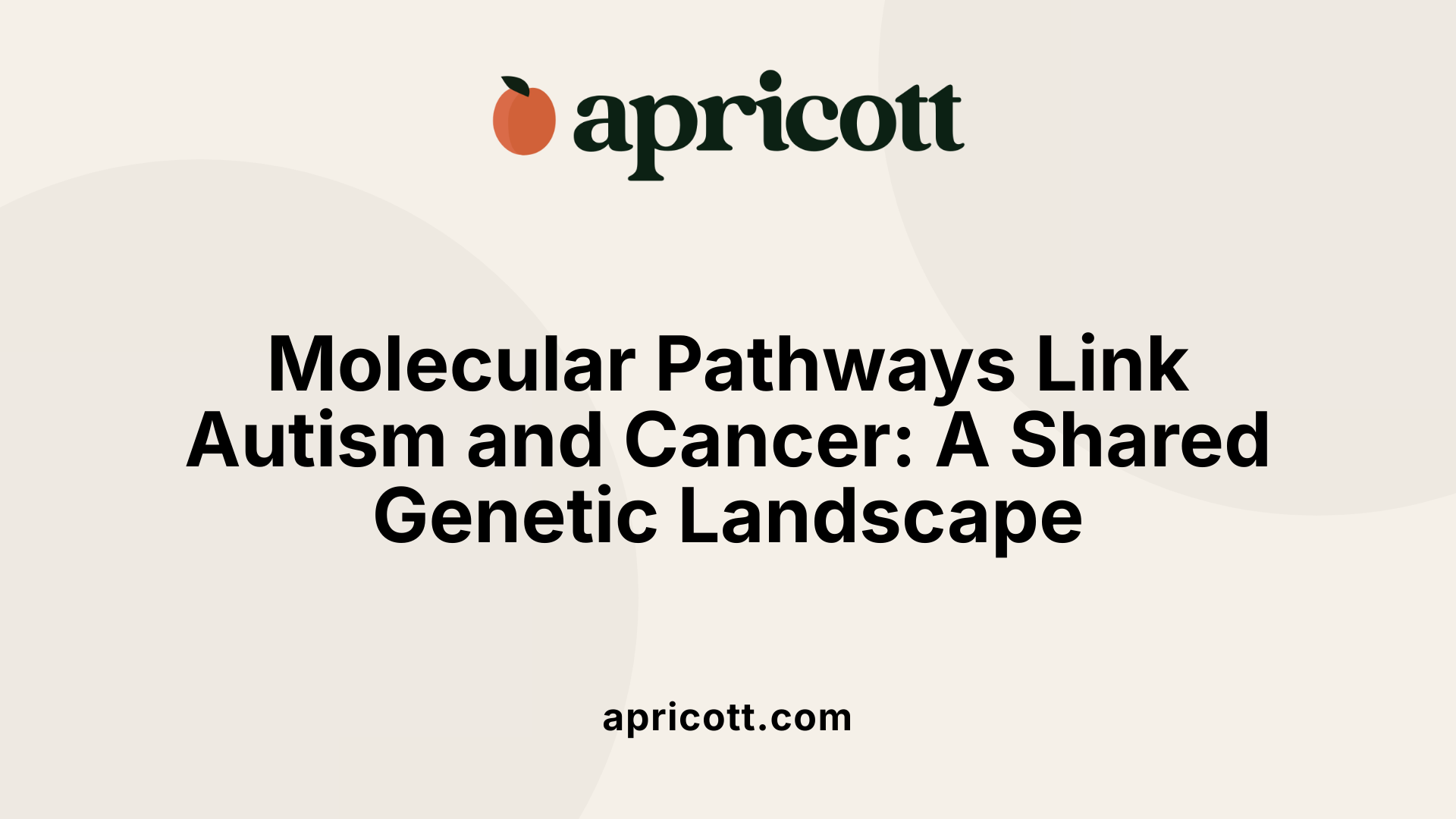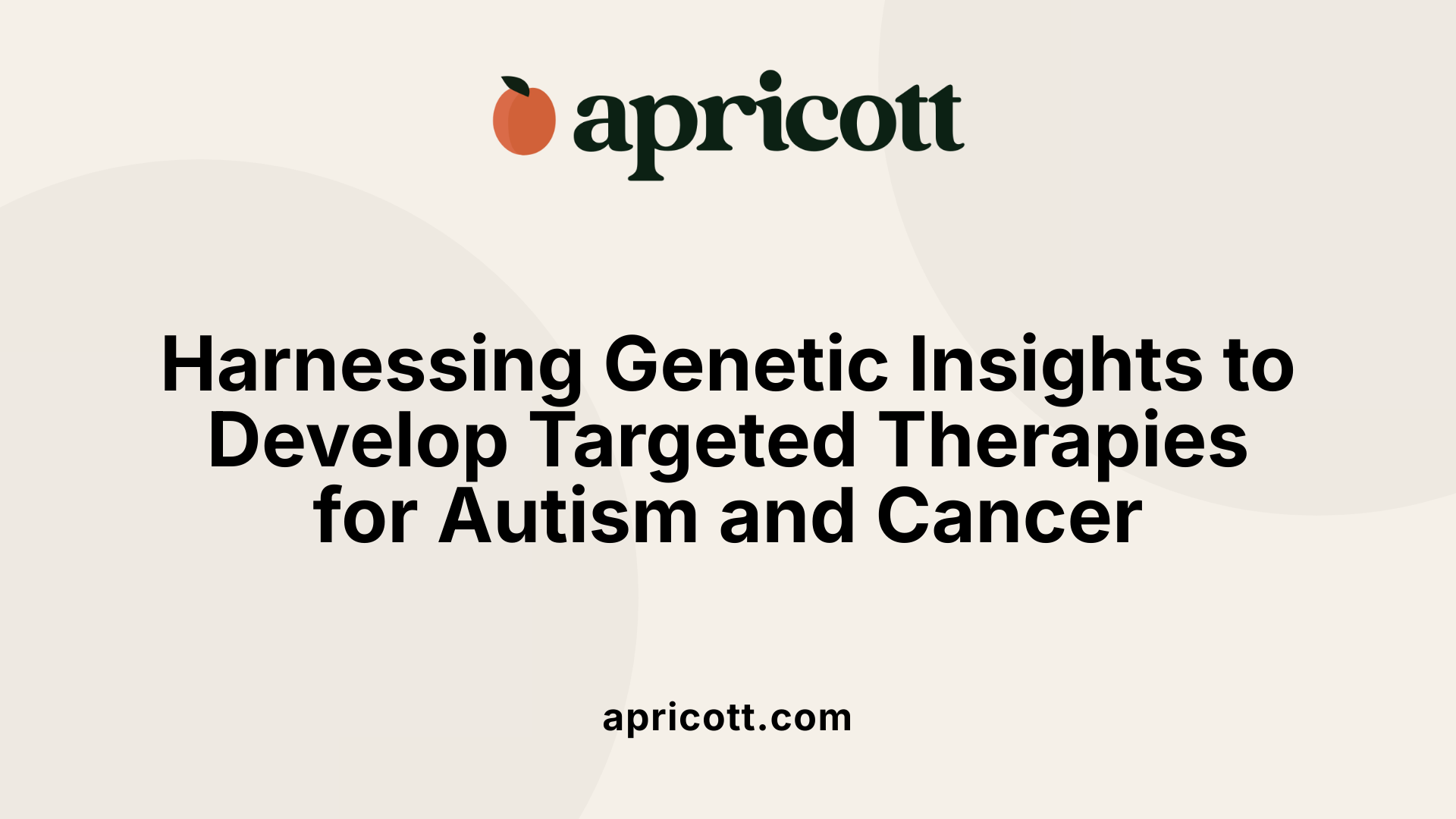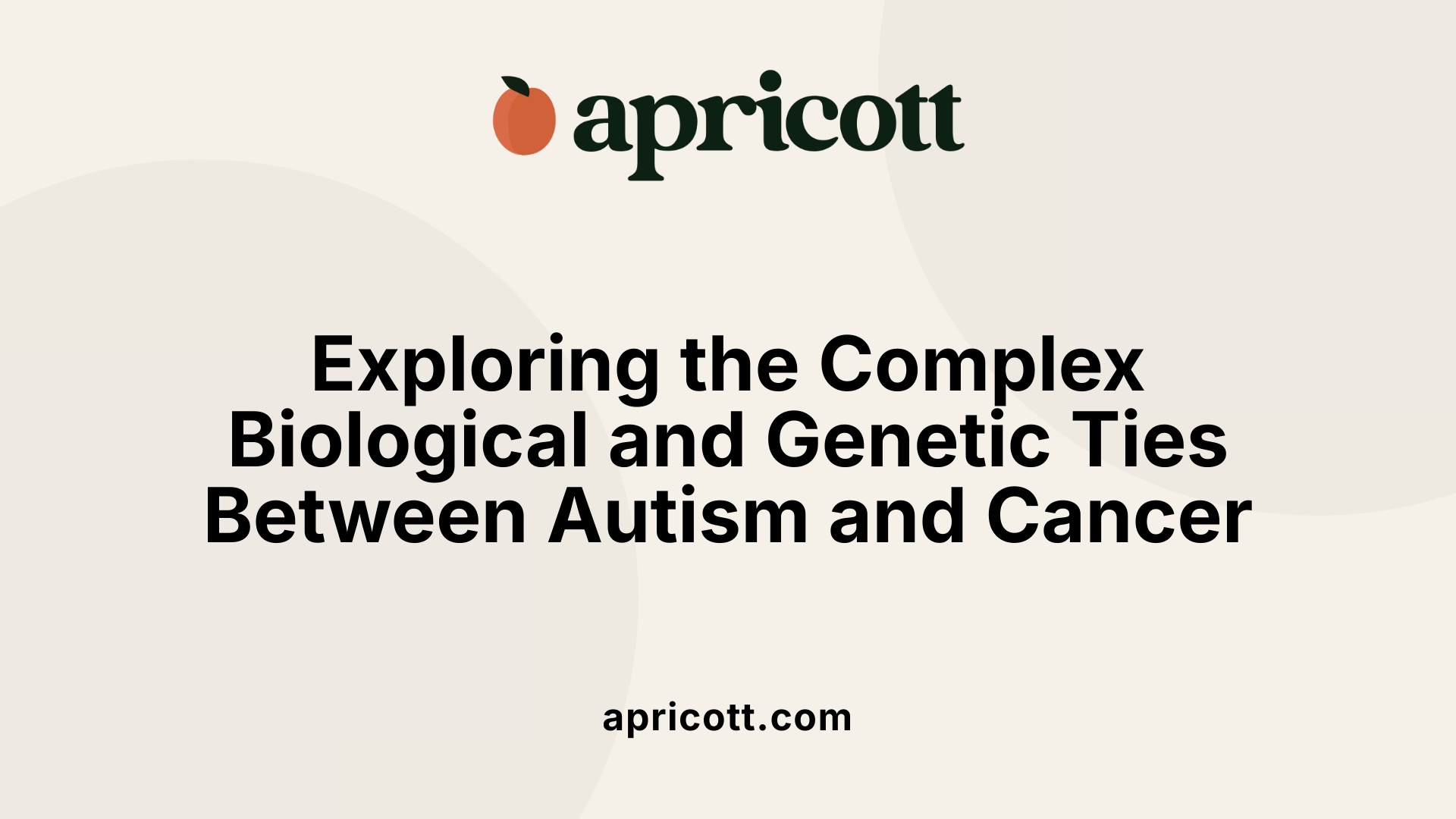August 13, 2025
Unraveling the Complex Relationship Between Autism and Cancer
The intersection of autism spectrum disorder (ASD) and cancer risk, genetics, and treatment is an area of growing scientific interest. While autism is primarily a neurodevelopmental condition, recent genetic and epidemiological studies suggest shared pathways and risk factors with cancer. This article examines the extent of this connection, the underlying biological mechanisms, and the implications for diagnosis and therapy, offering insights into how personalized approaches can improve care for autistic individuals facing cancer diagnoses.
Research shows that autism spectrum disorder (ASD) has a strong genetic basis, with heritability estimates typically ranging from 64% to over 90%. Twin studies are particularly revealing, as they demonstrate much higher concordance rates for autism in identical (monozygotic) twins compared to fraternal (dizygotic) twins. This indicates that genetics play a major role in autism.
Most genetic contributions to autism are polygenic, involving many common variants spread across the genome. In addition, rare mutations that arise spontaneously (de novo mutations) and copy number variations (CNVs) also significantly influence risk.
Environmental factors appear to have a minimal role, as studies suggest that shared environments contribute little to autism development. Instead, gene-environment interactions may influence individual outcomes.
This extensive genetic overlap not only helps understand autism but also its links to other conditions, such as cancer. Genes like PTEN, TSC1, and TSC2 are involved in both autism and cancer, highlighting complex biological connections.
Individuals with autism have a slightly increased overall risk of developing any type of cancer, with an odds ratio (OR) of 1.3. This means they are about 30% more likely to develop cancer compared to those without autism.
Interestingly, despite this increased risk, actual cancer diagnosis rates in the ASD population are lower overall. For example, only about 1.3% of autistic individuals are diagnosed with cancer versus 3.9% in the general population.
Research derived from large databases indicates that children under 14 with ASD have a 94% lower odds of having cancer compared to non-autistic children, which suggests protective or influencing factors that are not yet fully understood.
Certain subgroups within the ASD population show a higher association with cancer risk.
These statistics imply that when autism co-occurs with other developmental conditions, the likelihood of developing cancer increases significantly.
Research highlighting the genetic overlap shows that about 138 genes are common to both autism and various cancers. These shared genes regulate functions such as chromatin remodeling, DNA repair, and cell signaling.
Specific genes like PTEN, ERCC6, SMARCA2, ATRX, and UBE3A have been identified in both conditions. Mutations in genes such as NF1, TSC1, and TSC2—linked to neurofibromatosis and tuberous sclerosis—are associated with increased risks of cancer and autism.
Certain cancers, including kidney, pancreatic, thyroid, and brain cancers, are more prevalent among individuals with autism.
Recent advances in genome-wide exome sequencing reveal extensive genetic overlaps. The shared pathways involve genome maintenance, DNA repair, and cell proliferation.
Understanding these common pathways allows for exploring targeted treatments. For instance, drugs like rapamycin, which inhibits mTOR pathways affected by TSC mutations, are studied for autism subtypes with similar genetic changes.
This connection underscores the importance of genetics not only in predicting risks but also in developing therapies that address both autism and cancer mechanisms.

Recent research highlights significant overlap in the genetics and biological pathways of autism and cancer. Studies show that many risk genes are involved in both conditions, sharing functions related to chromatin remodeling, DNA repair, and genome stability.
Genes such as PTEN, ERCC6, SMARCA2, TSC1, TSC2, UBE3A, NF1, and CHD8 are linked to autism and also play roles in cancer development. For instance, PTEN is crucial for controlling cell growth and maintaining DNA stability. Mutations in PTEN can lead to increased cancer risk and are also associated with autism, especially in PTEN-ASD cases, which account for about 2% of all autism diagnoses.
Pathway analyses reveal that both autism and cancer involve critical signaling mechanisms like the MAPK, PI3K-Akt, and mTOR pathways. These pathways regulate cell proliferation, differentiation, and survival. Disruptions here can influence neural development and tumor formation alike.
Recent genome-wide exome sequencing studies have extensively mapped overlapping risk genes, confirming that alterations in genes governing genome maintenance, DNA repair, and cell signaling are common to both conditions. These shared pathways explain why some individuals with autism have genetic mutations that could predispose them to cancer.
Interestingly, while autism shows a genetic profile with more oncogenes—genes that promote cell growth—people with autism tend to have a lower overall risk of cancer compared to the general population. This paradox might be due to increased activity of certain protective pathways or differences in gene expression influencing cell proliferation.
Overall, the convergence of genetic pathways suggests a complex biological relationship. The overlap influences neural development in autism and tumor suppression in cancer, with pathway disruptions leading to either neurodevelopmental or oncogenic outcomes depending on the context and specific gene activity.
 Research indicates that autism spectrum disorder (ASD) shares molecular pathways and genetic risk factors with various types of cancer. Many of the genes involved in chromatin remodeling and genome maintenance are common to both conditions, playing crucial roles in how cells regulate DNA and respond to damage.
Research indicates that autism spectrum disorder (ASD) shares molecular pathways and genetic risk factors with various types of cancer. Many of the genes involved in chromatin remodeling and genome maintenance are common to both conditions, playing crucial roles in how cells regulate DNA and respond to damage.
Genes such as PTEN, TSC1, TSC2, and CHD8 are fundamental in neurodevelopmental processes but also participate in tumor suppression and cell growth regulation. Mutations in these genes can lead to both autism and increased susceptibility to certain cancers. For example, mutations in PTEN, a gene involved in cell proliferation control and DNA stabilization, are linked to autism and significantly elevate cancer risk, including breast cancer, with lifetime risk up to 85% in individuals with PTEN mutations.
Furthermore, genes like ERCC6, SMARCA2, and ATRX are vital in DNA repair mechanisms and chromatin remodeling. Disruptions in these genes can impair genome stability, fostering environments conducive to both neurodevelopmental disturbances and tumor formation. These overlaps suggest that certain genetic anomalies contribute to both ASD and cancer pathways.
Mutations affecting tumor suppressor genes and oncogenes also play a critical role. For instance, mutations in NF1, TSC1, and TSC2—associated with neurofibromatosis and tuberous sclerosis—are linked to increased cancer risk and autism spectrum disorder. Such genetic alterations influence cellular cycles and growth signals, tying together developmental alterations and oncogenic processes.
Recent advances, including genome-wide exome sequencing, have illuminated extensive overlaps in risk genes that govern genome maintenance, DNA repair, and cell proliferation. These findings reinforce the concept that shared genetic and molecular mechanisms underpin both autism and cancer, opening pathways for targeted therapies that could benefit both conditions.

Autism and cancer treatment intersect mainly through the exploration of shared genetic and molecular pathways, which can open avenues for novel therapies. While individuals with ASD have a slightly increased overall risk of developing cancer, they often face disparities in receiving timely and appropriate treatment. Such challenges stem from communication difficulties, sensory sensitivities, and unique behavioral responses.
Effective management of autism during cancer treatment involves a collaborative approach with caregivers, autism specialists, and healthcare providers. Strategies include the use of visual aids like storyboards and timers to manage expectations, as well as bringing comfort items such as tablets, soft blankets, or music to reduce anxiety.
Despite the higher prevalence of certain cancer-promoting oncogenes in people with autism—especially those involving genes like PTEN, TSC1, and TSC2—actual cancer incidence remains lower, with autistic individuals showing a 1.3% diagnosis rate compared to 3.9% in controls. This intriguing paradox suggests complex underlying genetic and biological factors.
Recent research indicates that molecular pathways involved in DNA repair, genome maintenance, and cell proliferation are common to both autism and various cancers. This overlap offers prospects for repurposing existing cancer drugs, such as rapamycin targeting TSC mutations, to potentially treat certain autism subtypes.
Advances in genome-wide sequencing have highlighted specific mutations and pathways as possible therapeutic targets. Personalized medicine approaches could tailor treatments based on an individual’s genetic profile, especially for autism cases linked to mutations like PTEN or CHD8.
While this field is still emerging, the intersection of autism and cancer research points toward a future where genetic and molecular insights drive innovative, targeted therapies, improving quality of life and treatment outcomes for autistic individuals.
| Aspect | Details | Additional Notes |
|---|---|---|
| Shared Genes | 138 genes between autism and cancer | Genes like PTEN, ERCC6, SMARCA2, ATRX |
| Common Pathways | Genome maintenance, DNA repair, cell proliferation | Targets for new treatments |
| Cancer Drugs | Rapamycin, others | Potential for repurposing |
| Genetic Focus | PTEN, TSC1, TSC2, CHD8 | Personalized treatment options |
| Treatment Goals | Enhance comfort, adapt procedures, leverage molecular overlaps | Essential for improved care during interventions |

Effective communication is essential when caring for autistic individuals during medical visits. Visual aids such as storyboards and picture schedules can help explain procedures and expectations clearly. Using visual guides allows patients to understand what will happen next, reducing anxiety and misunderstandings.
In addition, body language cues are significant. Being attentive to signs of discomfort, pain, or overstimulation—such as fidgeting, facial expressions, or withdrawal—can inform the healthcare provider’s approach and help prevent distress.
Many autistic people are sensitive to sensory stimuli like bright lights, loud noises, or unfamiliar textures. Creating a calm environment helps. This can include dimming lights, minimizing background noise, and bringing familiar objects such as a soft blanket or tablet for distraction. Allowing the patient to hold a comfort item or listen to music can also ease anxiety.
Autistic patients often benefit from individualized care plans tailored to their unique needs. Open communication between the healthcare team and family members ensures that specific triggers are addressed proactively. Advocating for the patient's preferences and comfort measures helps foster a supportive setting.
Music can serve as a calming tool, helping to regulate emotions and create a sense of familiarity. Incorporating preferred songs or musical activities into the visit may improve the experience.
Furthermore, recognizing and interpreting body language cues—such as signs of distress or fatigue—can guide interventions. Teaching staff to understand these non-verbal signals ensures a more responsive and empathetic approach.
| Approach | Description | Additional Tips |
|---|---|---|
| Visual Aids | Use storyboards, picture schedules, visual explanations | Tailor visuals to the child's interests |
| Sensory Adjustments | Reduce lighting, noise, and introduce familiar objects | Discuss preferences with caregivers |
| Advocacy and Planning | Personalized care plans, family collaboration | Review plans regularly with team |
| Music and Body Language | Calming music, watch for non-verbal cues | Use music that the patient enjoys |
By integrating these approaches, healthcare providers can create a more supportive, calming, and effective environment for autistic individuals during medical appointments.

Research suggests a complex relationship between autism spectrum disorder (ASD) and certain cancers. Individuals with ASD show a modestly increased overall risk of developing any cancer, with an odds ratio of 1.3. However, this risk is notably higher among those with narrowly defined autistic disorder or ASD accompanied by birth defects or intellectual disabilities. For example, ASD cases with co-occurring intellectual disability exhibit an odds ratio of 4.8, indicating a substantially elevated risk.
Genetic studies have deepened our understanding of this connection. Specific genes involved in both autism and cancer, such as PTEN, CHD8, and ERCC6, play roles in critical cellular processes like chromatin remodeling, DNA repair, and cell proliferation. These shared pathways suggest a common biological foundation. Cancers such as kidney, pancreatic, thyroid, and brain cancers are observed more frequently in the autistic community, further supporting potential biological links.
While the overall risk of cancer among individuals with ASD may appear modest, the presence of shared genetic risk factors underscores the importance of ongoing research to clarify these associations. Understanding the mechanisms behind these overlaps could lead to improved screening and targeted therapies.
Genetic analyses have revealed significant overlaps in risk genes for autism and various cancers. For example, mutations in genes associated with tumor suppression, like PTEN, can lead to both autism and increased cancer risk. Children with PTEN mutations are particularly vulnerable, with some facing an up to 85% lifetime risk of breast cancer.
Personalized approaches to care are essential. Recognizing genetic profiles can guide early interventions and monitoring for cancer development. Targeted treatments, such as cancer drugs that inhibit pathways impacted by genetic mutations (like rapamycin for TSC-related conditions), are being explored for autism subtypes with shared genetic features.
Despite promising insights, current data are limited and sometimes conflicting. More extensive epidemiological studies are needed to establish definitive links between ASD and specific types of cancer, particularly in diverse populations.
Biological research must continue to investigate the shared genetic pathways. Genome-wide exome sequencing has shown extensive overlap of risk genes, emphasizing the importance of understanding how these genes influence both neurodevelopment and tumor processes.
Identifying shared pathways opens avenues for novel treatments. Drugs that target common molecular mechanisms, such as those involved in DNA repair and cell proliferation, could benefit both autistic individuals and cancer patients. This translational approach offers hope for therapies that address underlying biological processes rather than only managing symptoms.
In summary, advancing genetic and biological research holds promise for developing tailored interventions, improving outcomes, and deepening our understanding of the mysterious links between autism and cancer.
The emerging body of evidence linking autism and cancer underscores the importance of continued research into shared genetic and biological pathways. Understanding these mechanisms not only clarifies potential risks but also opens avenues for targeted therapies and personalized medicine. Equally vital is the development of supportive clinical strategies tailored for autistic individuals undergoing treatment, ensuring they receive equitable and effective care. As the scientific community advances our understanding, fostering multidisciplinary collaboration and including autistic individuals in research will be key to translating these insights into improved health outcomes. The journey to unraveling the complex relationship between autism and cancer is ongoing, promising better prevention, diagnosis, and treatment solutions in the future.